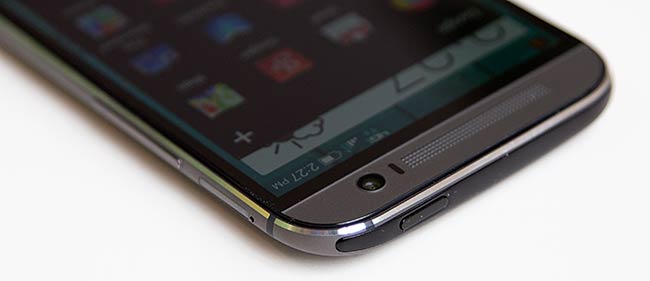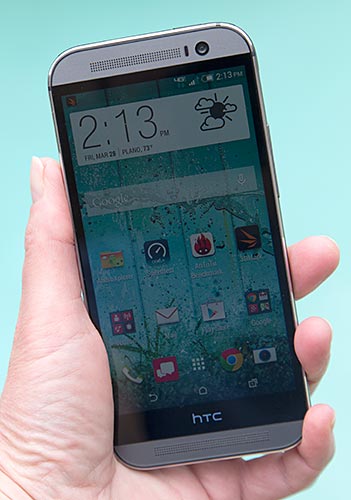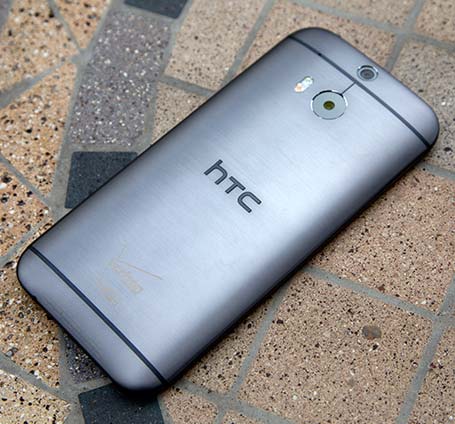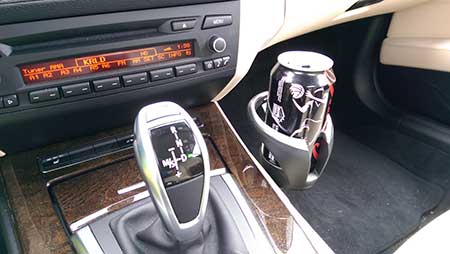HTC One M8 Review
12:51
The HTC One was one of our favorite phones for 2013: great construction and materials, a classy design, a large and sharp display and no manhandling of Android. For 2014 HTC is back with their flagship follow-up, the HTC One M8. It improves on most everything. There's even more metal in the casing and the brushed aluminum wraps around the sides so there's no polycarbonate sandwich. The display is even larger at 5" and it's still one of the nicer full HD smartphone panels on the market. HTC Sense 6 as ever offers tasteful, small customizations of Android without slapping on heavy skins. The old One's odd front buttons have been replaced by on-screen buttons, and we prefer that even if they do rob us of a little screen real estate.

As you'd expect, the internals have a boost too, with the Qualcomm Snapdragon 801 CPU clocked at 2.3GHz inside. This quad core CPU is fast yet power-frugal and it supports quick charging, unlike the old One that took forever to charge. This is a modest CPU improvement over the Snapdragon 800 that reigned king for a few months, but it does bring important support for DDR3 RAM, which can make for noticeable improvement in graphics performance. The HTC One M8 has 2 gigs of DDR3 RAM and 32 gigs of internal storage with ~23 gigs available. Even better, there's a microSD card slot compatible with SDXC cards for storage expansion. The phone runs Android 4.4 KitKat, and HTC Sense and BlinkFeed are now available as downloads from Google Play, so you won't have to wait for carrier firmware updates to get the latest tweaks.
The HTC One M8 will be available on all major carriers at the usual $199 with 2 year contract and $600 to $640 without contract. All carriers sell the new gray brushed aluminum "gunmetal gray" color, and Verizon also offers the light silver matte aluminum color matching the old One's finish. Lastly, there's a gold version that's available on AT&T, Sprint, Verizon and as a Google Play Edition (unlocked GSM) and unlocked developer edition (direct from HTC).

Design and Ergonomics
We have the new brushed aluminum model on Verizon wireless in for review, and it's simply stunning. It looks more like stainless steel and it's modern, elegant and unique. The white matte model looks much like the last generation HTC One and gold is the color of a gold bar. The phone's curves fit the hand perfectly and there's just enough straightness to the edges to provide grip. It's a tall phone among 5" models, but no taller than the Sony Xperia Z1S. It's taller than the Samsung Galaxy S4 and Nokia Lumia Icon. Why so tall? To accommodate the stereo HTC BoomSound speakers that flank the top and bottom of the display. Speaking of BoomSound, HTC says these speakers are 25% louder than the old One, and it is in fact as loud as some Ultrabooks we've reviewed. Beats audio is gone, since HTC sold their share of Beats, and that means a less bass-heavy sound.
This is a unibody phone with even more metal than the last model (90% vs. 70%). The polycarbonate on the sides is gone, along with the Oreo look. Some detail-minded folks fussed about the perfection or lack of perfection where the polycarbonate met metal on the old model, and now you've got clean wrap-around metal with a polished chamfer that's sure to please. In a world where most Android phones are shiny and plastic, the HTC One M8 is one of the few to take on the iPhone. Sony's Xperia line is the only other to pay so much attention to materials and design, but they do it with glass more than metal.

The top end cap isn't metal, but rather glossy black glass or plastic, and this area provides a window to the world for the many wireless radios in the phone. Metal edges surround this area so it's not vulnerable. The top power button might drive some folks crazy since it's hard to reach with one hand unless you have truly big mitts, so HTC added a tap to wake feature, not unlike LG's Knock On feature. Tapping twice on the screen gets the job done for me, so no complaints. The power button still does double-duty as the IR blaster window for the AV remote that works with HTC TV (powered by Peel and providing a TV programming guide in addition to remote control of your home theater gear).
The right side volume rocker is easy to operate (sometimes by accident) and it's well finished with no rattles. There's a nano SIM card tray on the left and a microSD card tray on the right--both require use of a paperclip or HTC's included poke tool to open. That's fine for the SIM since one normally doesn't remove that often, but annoying for the microSD card. I assume there wasn't enough room to add the SD card slot without resorting to the tiny little tray design. The micro USB port and headphone jack are located on the bottom and the 2600 mAh battery is sealed inside. This phone is locked up tight as a drum and it's not something that's easy to take apart for service. In fact, I suspect only factory service techs can do anything with the M8.
Display
The M8 has a 5" full HD LCD 1920 x 1080 display that's bright, extremely sharp and decently color accurate. It uses an IPS-like display and colors are natural rather than cartoony, and viewing angles are wide. It's viewable outdoors and whites are very bright and clean while blacks are decent but not as inky as AMOLED and Super AMOLED displays. Yes, it's a wee bit bigger than the last generation HTC One, but you do lose some screen acreage at the bottom for the three virtual Android buttons. These buttons will go into hiding mode when using full screen apps like Gallery or games, so they aren't visually intrusive. On the other hand, finding them can be trying-- tap in the vague area where they reside under a fog of black until they appear. Google wants manufacturers to move away from hardware buttons, so don't blame HTC if you dislike on-screen buttons.
Phone and Data
The HTC One M8 on Verizon has very good voice quality and average call volume through the earpiece. Incoming voice was clear and full and our call recipients said we sounded quite loud and also clear. As you might guess, speakerphone calls can really boom thanks to HTC's BoomSound speakers. The M8 behaved better with a variety of Bluetooth headsets and my car's built-in Bluetooth than did the HTC One M7 (old One) that was generally quieter than average for calls.
Data speeds were above average on our Verizon Wireless review unit, and near a highway and tower the phone exceeded 50mbps download speeds. The updated wireless chipset with higher max LTE speeds is taking care of business nicely here. Like all modern smartphones, the HTC One M8 has a mobile hotspot feature so you can use your phone as a high speed wireless modem for a laptop or tablet (your carrier may charge extra for this feature).
Benchmarks
We've already talked about the Snapdragon 801 quad core CPU with Adreno 330 graphics and DDR3 RAM support. It's currently the fastest smartphone chip on the market, and it leads the Snapdragon 800 by a small margin. HTC admitted that like Samsung, they game benchmarks, cranking up the CPU performance when the M8 detects popular benchmark apps are running. Samsung gave up the practice and removed the benchmark detection for Galaxy phones receiving the Android 4.4 KitKat update, and we'd like to see all manufacturers stop this.
Some HTC M8s (not US models at launch) have a setting in developer options to turn on high performance CPU mode for all apps. When playing 3D games, the phone gets warm on the back, but not hot. It gets warm enough that I wouldn't enable overclocking, since thermal throttling will likely negate it quickly enough.
The Cameras
The One has a very impressive 5 megapixel front camera with BSI and HDR. It can shoot 1080p video too, and that means high quality video chat. Given the popularity of selfies, we're glad to see a manufacturer actually care about front camera quality-- great stuff! I was truly impressed with video quality and you can see it in action in our video review.
The rear camera unfortunately sticks with the 4MP equivalent Ultrapixel camera seen on the last generation HTC One. The good part is just as with the M7, you get a wide aperture lens and larger pixel sites that capture more light, which can improve low light photos and generally improve shots. Indeed, the camera captures pleasing colors with good sharpness but it still handles high contrast scenes poorly with blown out whites. Colors tend toward the cool side, and are a bit less accurate than the iPhone 5s, Samsung Galaxy S5 and Nokia Lumia 1520/Nokia Lumia Icon. The drawback of the 4MP equivalent sensor is the relatively low resolution of photos; there isn't much opportunity for cropping without things becoming a blotchy mess. But taken as a whole, the images are good, and if you don't do more than post to Facebook or personal blogs, then it's a perfectly adequate camera. If you're a camera enthusiast (as I admittedly am) hoping to use your smartphone as a decent point and shoot digicam substitute, the M8's exposure and sometimes bleached look HDR shots won't win hearts and eyeballs. HDR certainly could be improved with a software update, and given how actively HTC is issuing software updates via Google Play, perhaps we'll see some tweaks soon.

Above: a pleasing photo taken in even lighting on a partly cloudy day.
Below: notice how high contrast results in blown out highlights and a loss of detail.
Below: notice how high contrast results in blown out highlights and a loss of detail.

Sadly, the HTC One M8 loses the optical image stabilization that we loved in the old One and in various Nokia Windows phones. We particularly missed it for video recording where it would have helped calm video jitters. 1080p video capture has pleasing colors and decent contrast, though we noticed the same tendency to blow out highlights as we saw on with photos. In evenly lit settings, including night settings, the camera can acquire some nice footage with very good audio quality.
HTC added a secondary rear camera, and thankfully this doesn't herald a return to the failed 3D smartphone cameras of old. Instead it captures depth info to aide in software photo editing features like Ufocus that let you create background blur and Dimension Plus that does a 3D perspective shift that you enact by tilting the camera (if that's hard to imagine, watch our video where I demo the feature--it's actually cool). And yes, Zoe is still here so you can create a short presentation of moving photos.
Battery Life
Good news, the HTC One M8 has better battery life than the first gen One and it beats many other current smartphones on the market. We had a hard time killing the 2600 mAh Lithium Ion with a heavy day of use that included streaming video for an hour, using the GPS for a half hour trip, 30 minutes of calls, taking 40 photos and 5 full HD videos and playing 45 minutes of games (Real Racing 3 mostly). Rather than plugging the phone in before bed, we let it sit idle overnight and still had enough juice to power through until 11am. Nice. We didn't dip below 7 hours of actual screen on time, which is quite good for today's phones... watch out, LG G2 you have competition.


0 comments